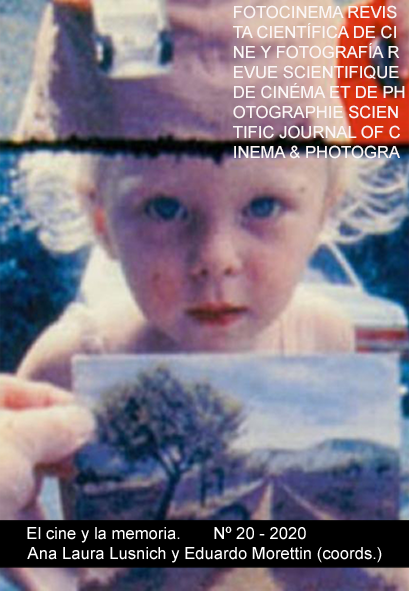Between recall and return. Memory and history of a ghost in A Ghost Story (David Lowery, 2017)
DOI:
https://doi.org/10.24310/Fotocinema.2020.v0i20.7622Keywords:
Ghosts, memory, time, death, horror, narratology.Abstract
This article studies the concept of memory in the movie A Ghost Story. This work by David Lowery presents a ghost covered by a sheet, condemned to saunter in the realm of the living. We are interested in answering the question of how the film represents some ideas related to time, death and recall. In this ghostly story some of the recurring motives of fantasy and horror genre can be identified. However, these common places are reinterpreted and framed in a romantic drama with a complex narrative structure. In addition, the nature of the story implies certain problems related to the temporality of the cinematographic image. Hence, we are interested in studying the processes of significance and persuasion that make the misadventures of this wandering spectre bealivable. To do so, two methodologies will be used: narratological analysis and film analysis. Specifically, we will rely on the concepts of order, duration and frequency coined by Gérard Genette, located in specific sequences of the film.
Downloads
Metrics
Publication Facts
Reviewer profiles N/A
Author statements
Indexed in
-
—
- Academic society
- N/A
- Publisher
- Universidad de Málaga
References
Aumont, J. & Marie, M. (1990). Análisis del film. Barcelona: Paidós.
Acevedo Nieto, J. & Marcos Ramos, M. (2018). Tren de Sombras: An Aesthetic of Memory. L'Atalante. Revista de estudios cinematográficos, 26?-54.
Casetti. F. & Di Chio, F. (1991). Cómo analizar un film. Barcelona: Paidós.
Eliade, M. (1985). El mito del eterno retorno. Arquetipos y repetición. Madrid: Alianza.
Gaudreault, A. & Jost, F. (1995). El relato cinematográfico. Barcelona: Paidós.
Genette, G. (1989). Figuras III. Barcelona: Lumen.
Grainge, P. (2003). Introduction. Memory and popular film. Manchester University Press, 1-21.
Leandro-Hernández, L. (2018): Escribir la realidad a través de la ficción: el papel del fantasma y la memoria en «Cuando hablábamos con los muertos», de Mariana Enríquez. Brumal, Vol. VI, n.º 2 (otoño), 145-164.
Leutrat, J.L. (1999). Vida de fantasmas. Lo fantástico en el cine. Valencia: Ediciones de la Mirada.
López-Aparicio I. & Sánchez Ruiz, J. (2008). La memoria: una estructura para la creación. Arte, Individuo y Sociedad vol. 20, 21-42.
Lovecraft, H.P. (1989). El horror en la literatura. Madrid: Alianza.
Luque, F. (2013). Tiempo, memoria, imagen: Sans soleil de Chris Marker. Fotocinema. Revista científica de cine y fotografía nº7, 209-240.
Fioretti, L. (2012). Sarduy-Derrida: cenizas de la escritura o la escritura como ceniza. Una lectura sobre la memoria y el olvido. Escritura e imagen Vol.8, 209-226.
Meana-Martínez, J.C. (2017). La imagen de la muerte: reflexiones sobre su representación. Arte, individuo y sociedad 29(2): 317-332
Mitry, J. (1978). Estética y psicología del cine. 2. Las formas. Madrid: Siglo XXI.
Roas, D. (2011) Tras los límites de lo real, una definición de lo fantástico. Málaga: Páginas de Espuma.
Rosset, C. (1993). Lo real y su doble. Barcelona: Tusquets.
Sartre, J.P. (1976). Lo imaginario. Psicología fenomenológica de la imaginación. Buenos Aires: Editorial Losada.
Sedeño, A. (2016). Imaginarios del cuerpo y la memoria del cine contemporáneo: reflexiones sobre el cine de Miguel Gomes y Joao Pedro Rodrigues. Fotocinema. Revista científica de cine y fotografía, nº 13, 267-280.
Todorov, T. (1982). Introducción a la literatura fantástica. Barcelona: Ediciones Buenos Aires.
Turim, M. (1998). Flashbacks in film. Memory and history. Nueva York: Routledge.
Zizek, S. (2011). El acoso de las fantasías. Madrid: Akal.
Zubiaur Gorozika, N. E. (2019). La reconstrucción de la memoria contra la irreversibilidad del tiempo. Reescrituras del melodrama en el cine de Juan José Campanella. Revista Signa 28, 1601-1631.
Zunzunegui, S. (2016). La mirada cercana. Microanálisis fílmico. Santander: Shangrila.
Downloads
Published
How to Cite
Issue
Section
License
All contents published in Fotocinema Revista científica de cine y fotografía are protected under the Creative Commons Attribution-NonCommercial-ShareAlike 4.0 International (CC BY-NC-SA 4.0) license. All about this license is available in the following link: <http://creativecommons.org/licenses/by-nc-sa/4.0>
Users can copy, use, redistribute, share and exhibit publicly as long as:
- The original source and authorship of the material are cited (Journal, Publisher and URL of the work).
- It is not used for comercial purposes.
- The existence of the license and its especifications are mentioned.
There are two sets of authors’ rights: moral and property rights. Moral rights are perpetual prerogatives, unrenounceable, not-transferable, unalienable, imprescriptible and inembargable. According to authors’ rights legislation, Fotocinema. Revista científica de cine y fotografía recognizes and respects authors moral rights, as well as the ownership of property rights, which will be transferred to University of Malaga in open access. The property rights are referred to the benefits that are gained by the use or the dissemination of works. Fotocinema. Revista científica de cine y fotografía is published in an open access form and it is exclusively licenced by any means for doing or authorising distribution, dissemination, reproduction, , adaptation, translation or arrangement of works.
Authors are responsable for obtaining the necessary permission to use copyrighted images.














13.png)



